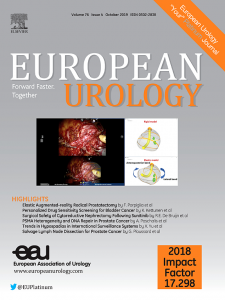Genomic and Transcriptomic Profiling of High-risk Bladder Cancer Reveals Diverse Molecular and Microenvironment Ecosystems
IF 25.2
1区 医学
Q1 UROLOGY & NEPHROLOGY
引用次数: 0
Abstract
Background and objective
High-risk bladder cancer recurs in 30% of cases and causes fatal outcomes in 10% within 2 yr despite surgical resection, endoscopic surveillance, and bacillus Calmette-Guérin (BCG) immunotherapy. The global shortage of BCG highlights the urgent need for alternative or complementary strategies. This study aimed to identify molecular subtypes and develop a precision framework to predict recurrence risk and guide treatment.Methods
Transcriptomic profiling and targeted genomic sequencing were performed with validation by single-cell RNA sequencing and spatial transcriptomics. A machine learning model incorporating genomic and transcriptomic features was developed to predict recurrence risk.Key findings and limitations
Four subtypes were identified, and an inflamed tumor subtype with high endogenous retroelement expression and increased commensal bacterial presence demonstrated the highest responsiveness to BCG therapy. The predictive model achieved high accuracy (area under the curve = 0.87, 95% confidence interval: 0.72–1.0) for recurrence risk. Findings are limited by sample size, necessitating validation in larger cohorts.Conclusions and clinical implications
We describe a new conceptual framework for T1 tumors. Those with increased immune cells (subtype 2) have a better response to BCG, which may be secondary to enhanced baseline immune activity.高危膀胱癌的基因组和转录组学分析揭示了不同的分子和微环境生态系统
背景与目的尽管采用手术切除、内镜监测和卡介苗免疫治疗,高危膀胱癌在2年内仍有30%的病例复发,10%的病例死亡。波士顿咨询公司的全球短缺凸显了对替代或补充战略的迫切需要。本研究旨在鉴定分子亚型,并建立精确的框架来预测复发风险和指导治疗。方法利用单细胞RNA测序和空间转录组学技术进行转录组学分析和靶向基因组测序。结合基因组学和转录组学特征的机器学习模型被开发用于预测复发风险。主要发现和局限性鉴定了四种亚型,其中内源性逆转录因子高表达和共生细菌增加的炎症肿瘤亚型对卡介苗治疗的反应性最高。预测模型对复发风险具有较高的准确度(曲线下面积= 0.87,95%置信区间:0.72-1.0)。研究结果受样本量的限制,需要在更大的队列中进行验证。结论和临床意义我们描述了T1肿瘤的一个新的概念框架。那些免疫细胞(亚型2)增加的人对卡介苗有更好的反应,这可能是继发于基线免疫活性增强。
本文章由计算机程序翻译,如有差异,请以英文原文为准。
求助全文
约1分钟内获得全文
求助全文
来源期刊

European urology
医学-泌尿学与肾脏学
CiteScore
43.00
自引率
2.60%
发文量
1753
审稿时长
23 days
期刊介绍:
European Urology is a peer-reviewed journal that publishes original articles and reviews on a broad spectrum of urological issues. Covering topics such as oncology, impotence, infertility, pediatrics, lithiasis and endourology, the journal also highlights recent advances in techniques, instrumentation, surgery, and pediatric urology. This comprehensive approach provides readers with an in-depth guide to international developments in urology.
 求助内容:
求助内容: 应助结果提醒方式:
应助结果提醒方式:


